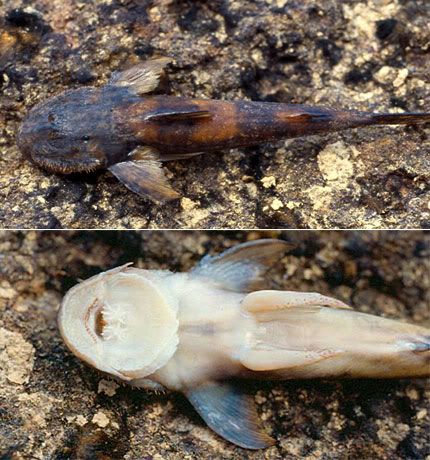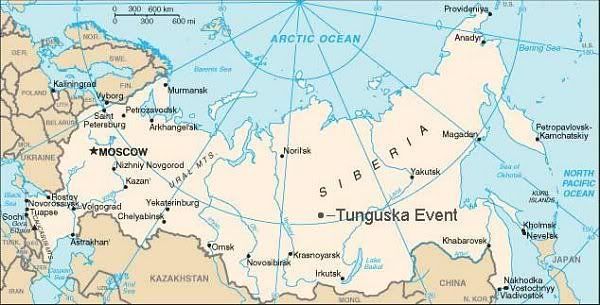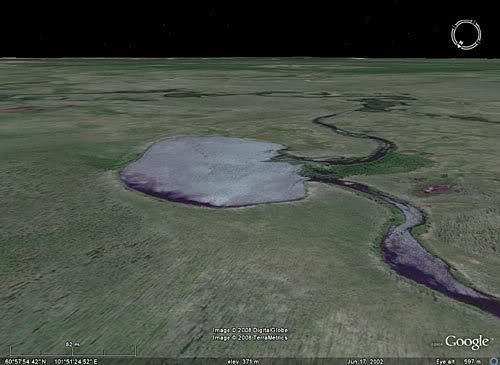
Over 16,536,469 people are on fubar.
What are you waiting for?

 January 22, 2009—This fish out of water is a newly identified species from a remote region in Venezuela.
The catfish handily inches along rocks using its highly flexible pelvic fins (bottom, the two leg-like appendages) and wide mouth as grasping tools. Such climbing ken may be crucial for the fish, which live in strong, high-flow streams.
An anthropologist first collected the fish in the state of Amazonas about two decades ago, but the odd sample brought to Caracas's Instituo de Zoologíca looked "like it was run over by a truck," American Museum of Natural History ichthyologist Scott Schaefer said in a statement.
Intrigued, Schaefer and colleagues eventually pinpointed the source of the fish—a tributary of the Orinoco River—and literally picked 84 specimens off of rocks.
New analysis of the samples, published in the journal American Museum Novitates, confirmed that the new species, dubbed Lithogenes wahari, belongs to a group of fish that span two families.
Bony plates on its head and tail (top) link the creature to Loricariidae, a family of armored catfishes.
But its specialized pelvic fins—which move backward and forward independently—are seen only in Astroblepidae, a family of climbing catfish found in the Andes.
(Related story: "Fish Lives in Logs, Breathing Air, for Months at a Time" [November 6, 2007].)
The combination of features suggests that common ancestors to both fish families lived in upland streams of the Amazon and Orinoco Rivers, which currently house most of the groups' members.
"We see new fish species all the time," Schaefer said, "but when you also get new information about the biological history of a group, it's the most fun."
—Christine Dell'Amore
Photograph courtesy S. Schaefer/AMNH
January 22, 2009—This fish out of water is a newly identified species from a remote region in Venezuela.
The catfish handily inches along rocks using its highly flexible pelvic fins (bottom, the two leg-like appendages) and wide mouth as grasping tools. Such climbing ken may be crucial for the fish, which live in strong, high-flow streams.
An anthropologist first collected the fish in the state of Amazonas about two decades ago, but the odd sample brought to Caracas's Instituo de Zoologíca looked "like it was run over by a truck," American Museum of Natural History ichthyologist Scott Schaefer said in a statement.
Intrigued, Schaefer and colleagues eventually pinpointed the source of the fish—a tributary of the Orinoco River—and literally picked 84 specimens off of rocks.
New analysis of the samples, published in the journal American Museum Novitates, confirmed that the new species, dubbed Lithogenes wahari, belongs to a group of fish that span two families.
Bony plates on its head and tail (top) link the creature to Loricariidae, a family of armored catfishes.
But its specialized pelvic fins—which move backward and forward independently—are seen only in Astroblepidae, a family of climbing catfish found in the Andes.
(Related story: "Fish Lives in Logs, Breathing Air, for Months at a Time" [November 6, 2007].)
The combination of features suggests that common ancestors to both fish families lived in upland streams of the Amazon and Orinoco Rivers, which currently house most of the groups' members.
"We see new fish species all the time," Schaefer said, "but when you also get new information about the biological history of a group, it's the most fun."
—Christine Dell'Amore
Photograph courtesy S. Schaefer/AMNH This model initially struggled to explain the ripples in the temperature and density of the universe that can be seen in the cosmic microwave background radiation left over from the big bang. The only way to make calculations based on the cyclic model produce the observed pattern of ripples is to add extra dimensions, as predicted by string theory, on top of the four spatial dimensions that the initial scenario envisaged.
Unfortunately, adding extra dimensions throws up another problem. As two branes approach, the additional dimensions must shrink or grow in sync with the dimension that separates the branes. Otherwise, large areas of the brane become warped, so that most of it ends up as black holes and only a tiny proportion as ordinary, habitable space. After several cycles, this space shrinks to nothing, so the process is unlikely to have led to our universe.
Without dark energy, most of the brane would end up as black holes, leaving only a tiny proportion as habitable space
Now calculations by Steinhardt and Jean-Luc Lehners, also at Princeton, show that when dark energy - the stuff that appears to be causing the expansion of the universe to accelerate - is brought into the picture, the cycling can be sustainable, so long as dark energy dominates for around 600 billion years.
In earlier cyclic models, dark energy has merely kept the cycles stable, and only dominated for the first 10 billion years or so. The pair say their calculations show that dark energy may in fact last much longer, and so is "absolutely essential" for the endurance of habitable regions. After each clash it would stretch the habitable regions so there is enough left after the next clash, and so on in subsequent cycles (see diagram). "Most of the universe is consumed in ashes, but the phoenix universe emerges once again from the small surviving seed," says Steinhardt (www.arxiv.org/abs/0812.3388).
This model initially struggled to explain the ripples in the temperature and density of the universe that can be seen in the cosmic microwave background radiation left over from the big bang. The only way to make calculations based on the cyclic model produce the observed pattern of ripples is to add extra dimensions, as predicted by string theory, on top of the four spatial dimensions that the initial scenario envisaged.
Unfortunately, adding extra dimensions throws up another problem. As two branes approach, the additional dimensions must shrink or grow in sync with the dimension that separates the branes. Otherwise, large areas of the brane become warped, so that most of it ends up as black holes and only a tiny proportion as ordinary, habitable space. After several cycles, this space shrinks to nothing, so the process is unlikely to have led to our universe.
Without dark energy, most of the brane would end up as black holes, leaving only a tiny proportion as habitable space
Now calculations by Steinhardt and Jean-Luc Lehners, also at Princeton, show that when dark energy - the stuff that appears to be causing the expansion of the universe to accelerate - is brought into the picture, the cycling can be sustainable, so long as dark energy dominates for around 600 billion years.
In earlier cyclic models, dark energy has merely kept the cycles stable, and only dominated for the first 10 billion years or so. The pair say their calculations show that dark energy may in fact last much longer, and so is "absolutely essential" for the endurance of habitable regions. After each clash it would stretch the habitable regions so there is enough left after the next clash, and so on in subsequent cycles (see diagram). "Most of the universe is consumed in ashes, but the phoenix universe emerges once again from the small surviving seed," says Steinhardt (www.arxiv.org/abs/0812.3388).

 This is not the first use of the term "phoenix universe". It was coined in 1933 by Georges Lemaître, an advocate of the big bang theory. "Our model is a more appropriate use of the name," Steinhardt claims. "We were motivated by the same conceptual issue: what happened at the big bang. Was it the beginning or not?"
Like its predecessors, the pair's work is built on a variant of string theory called M-theory which has yet to be completely fleshed out, says Peter Coles of the University of Cardiff in the UK. Andrew Liddle of the University of Sussex, UK, describes their model as a "neat and novel" picture, but adds that it is "hard to believe that we'll ever make observations that could show whether it is right or not".
However, Martin Bojowald of Pennsylvania State University, University Park, says their model is "more realistic" than previous versions, and that future measurements of dark energy may allow the idea to be tested.
This is not the first use of the term "phoenix universe". It was coined in 1933 by Georges Lemaître, an advocate of the big bang theory. "Our model is a more appropriate use of the name," Steinhardt claims. "We were motivated by the same conceptual issue: what happened at the big bang. Was it the beginning or not?"
Like its predecessors, the pair's work is built on a variant of string theory called M-theory which has yet to be completely fleshed out, says Peter Coles of the University of Cardiff in the UK. Andrew Liddle of the University of Sussex, UK, describes their model as a "neat and novel" picture, but adds that it is "hard to believe that we'll ever make observations that could show whether it is right or not".
However, Martin Bojowald of Pennsylvania State University, University Park, says their model is "more realistic" than previous versions, and that future measurements of dark energy may allow the idea to be tested. Excavations on the island have yielded the remains of at least six turtles that learnt to swim during the age of the dinosaurs.
Eileanchelys waldmani, the species that started swimming in the island’s lakes and lagoons, represents the missing link in the evolution of turtles that palaeontologists have long sought.
Its limbs were similar to those of modern freshwater turtles rather than the flippers of sea-going species, but are likely to have had webbing between the claws.
Related Links
We must defend our high seas
Two-headed beast from 100m BC
Scientists concluded that the newly discovered species was aquatic because the fossils were found in rock that once formed the bottom of a lake or lagoon, and because unlike the remains of contemporary land animals, which were fragmented having been washed into a pool, the turtles were relatively complete and articulated.
“Eileanchelys waldmani can be plausibly interpreted as the earliest known aquatic turtle,” researchers concluded in their report published in the journal Proceedings of the Royal Society.
Although Skye is swept by often ferocious Atlantic storms today, the conditions were markedly different during the Middle Jurassic, when the turtle evolved. Then, the island was part of a coastal region of a much bigger land mass, dotted with low salinity lagoons and freshwater lakes and ponds.
The weather was much warmer than today, and other fossil remains have shown that the turtle lived alongside creatures such as salamanders, sharks and crocodiles.
Jérémy Anquetin, of the Natural History Museum and one of the researchers who analysed the fossilised turtles, said: “Although the majority of modern turtles are aquatic forms, it has been convincingly demonstrated that the most primitive turtles from the Triassic, about 210 million years ago, were exclusively terrestrial.
“Until the discovery of Eileanchelys, we thought that adaptation to an aquatic habitat might have appeared among primitive turtles but we had no fossil evidence of that.
“Now we know for sure that there were aquatic turtles around 164 million years ago. This discovery also demonstrates that turtles were more ecologically diverse early in their history than had been suspected before.”
The turtle fossils were recovered from a slab of rock cut out in 2004. Each was encased in the slab and it took months to release them. They were analysed by researchers from the Natural History Museum and University College London, and the fossils are now in the collection of National Museums Scotland.
Excavations on the island have yielded the remains of at least six turtles that learnt to swim during the age of the dinosaurs.
Eileanchelys waldmani, the species that started swimming in the island’s lakes and lagoons, represents the missing link in the evolution of turtles that palaeontologists have long sought.
Its limbs were similar to those of modern freshwater turtles rather than the flippers of sea-going species, but are likely to have had webbing between the claws.
Related Links
We must defend our high seas
Two-headed beast from 100m BC
Scientists concluded that the newly discovered species was aquatic because the fossils were found in rock that once formed the bottom of a lake or lagoon, and because unlike the remains of contemporary land animals, which were fragmented having been washed into a pool, the turtles were relatively complete and articulated.
“Eileanchelys waldmani can be plausibly interpreted as the earliest known aquatic turtle,” researchers concluded in their report published in the journal Proceedings of the Royal Society.
Although Skye is swept by often ferocious Atlantic storms today, the conditions were markedly different during the Middle Jurassic, when the turtle evolved. Then, the island was part of a coastal region of a much bigger land mass, dotted with low salinity lagoons and freshwater lakes and ponds.
The weather was much warmer than today, and other fossil remains have shown that the turtle lived alongside creatures such as salamanders, sharks and crocodiles.
Jérémy Anquetin, of the Natural History Museum and one of the researchers who analysed the fossilised turtles, said: “Although the majority of modern turtles are aquatic forms, it has been convincingly demonstrated that the most primitive turtles from the Triassic, about 210 million years ago, were exclusively terrestrial.
“Until the discovery of Eileanchelys, we thought that adaptation to an aquatic habitat might have appeared among primitive turtles but we had no fossil evidence of that.
“Now we know for sure that there were aquatic turtles around 164 million years ago. This discovery also demonstrates that turtles were more ecologically diverse early in their history than had been suspected before.”
The turtle fossils were recovered from a slab of rock cut out in 2004. Each was encased in the slab and it took months to release them. They were analysed by researchers from the Natural History Museum and University College London, and the fossils are now in the collection of National Museums Scotland.
 Hiroshima mushroom cloud
Image: University of Maine
On June 30, 1908, the Earth experienced an explosion 1,000 times the magnitude of the the atomic bomb dropped on Hiroshima, Japan (shown above). The event resulted in the flattening of 80 million trees over an area roughly the size of Washington DC, and a century later scientists and UFO enthusiasts are still debating about what caused this colossal 5-30 megaton blast, and what happened to its mysterious remains.
Hiroshima mushroom cloud
Image: University of Maine
On June 30, 1908, the Earth experienced an explosion 1,000 times the magnitude of the the atomic bomb dropped on Hiroshima, Japan (shown above). The event resulted in the flattening of 80 million trees over an area roughly the size of Washington DC, and a century later scientists and UFO enthusiasts are still debating about what caused this colossal 5-30 megaton blast, and what happened to its mysterious remains.
 Map of Russia
Image: WikiMedia Commons
Dubbed the Tunguska Event, or Tunguska Explosion, because of the location of the blast in the Tunguska Valley of Russia, the event would have registered a devastating 5.0 on the Richter Scale, had it been invented at the time. And had it occurred about five hours later in the day, the Earth’s rotation would have guaranteed that instead of killing 1,000 reindeer, the blazing object would have completely wiped out St Petersburg.
Instead, and luckily for us, the explosion happened at approximately 7:17 in the morning in isolated Siberia where only one unfortunate person died from the blast. Locals first noticed an extraterrestrial object zip bright blue across the clear sky; not long afterward, there was a flash, intense, blistering heat and loud thundering. Windows broke and people were knocked to the ground.
Russian mineralogist Leonid Kulik obtained this testimony from S Semenov during his 1930 Tunguska expedition:
“I suddenly saw that directly to the North, over Onkoul’s Tunguska road, the sky split in two and fire appeared high and wide over the forest… The split in the sky grew larger, and the entire Northern side was covered with fire. At that moment I became so hot that I couldn’t bear it, as if my shirt was on fire; from the northern side, where the fire was, came strong heat. I wanted to tear off my shirt and throw it down, but then the sky shut closed, and a strong thump sounded, and I was thrown a few yards. I lost my senses for a moment, but then my wife ran out and led me to the house. After that such noise came, as if rocks were falling or cannons were firing, the earth shook, and when I was on the ground, I pressed my head down, fearing rocks would smash it. When the sky opened up, hot wind raced between the houses, like from cannons, which left traces in the ground like pathways, and it damaged some crops. Later we saw that many windows were shattered, and in the barn a part of the iron lock snapped.”
Map of Russia
Image: WikiMedia Commons
Dubbed the Tunguska Event, or Tunguska Explosion, because of the location of the blast in the Tunguska Valley of Russia, the event would have registered a devastating 5.0 on the Richter Scale, had it been invented at the time. And had it occurred about five hours later in the day, the Earth’s rotation would have guaranteed that instead of killing 1,000 reindeer, the blazing object would have completely wiped out St Petersburg.
Instead, and luckily for us, the explosion happened at approximately 7:17 in the morning in isolated Siberia where only one unfortunate person died from the blast. Locals first noticed an extraterrestrial object zip bright blue across the clear sky; not long afterward, there was a flash, intense, blistering heat and loud thundering. Windows broke and people were knocked to the ground.
Russian mineralogist Leonid Kulik obtained this testimony from S Semenov during his 1930 Tunguska expedition:
“I suddenly saw that directly to the North, over Onkoul’s Tunguska road, the sky split in two and fire appeared high and wide over the forest… The split in the sky grew larger, and the entire Northern side was covered with fire. At that moment I became so hot that I couldn’t bear it, as if my shirt was on fire; from the northern side, where the fire was, came strong heat. I wanted to tear off my shirt and throw it down, but then the sky shut closed, and a strong thump sounded, and I was thrown a few yards. I lost my senses for a moment, but then my wife ran out and led me to the house. After that such noise came, as if rocks were falling or cannons were firing, the earth shook, and when I was on the ground, I pressed my head down, fearing rocks would smash it. When the sky opened up, hot wind raced between the houses, like from cannons, which left traces in the ground like pathways, and it damaged some crops. Later we saw that many windows were shattered, and in the barn a part of the iron lock snapped.”
 Fallen trees
Image: WikiMedia Commons
Thousands of miles away, changes in atmospheric pressure occurred. For weeks, the night skies in England glowed with an eerie light caused by dust from the explosion. It was so bright that people didn’t even need their lamps to read!
And what makes this event more bizarre is that the explosion seemed to have occurred in the sky; the actual impact from this object, whether asteroid, comet, or UFO cannot be found. Some accounts even note that the unidentified object made two 45 degree angle turns to avoid harming human life before it blew up, and that a mysterious, towering human/yeti-like creature haunted the woods years after the blast. This led alien pundits to claim that life forms from another planet were trying to make what would turn out to be an unsuccessful emergency landing on Earth.
Lake Cheko
Fallen trees
Image: WikiMedia Commons
Thousands of miles away, changes in atmospheric pressure occurred. For weeks, the night skies in England glowed with an eerie light caused by dust from the explosion. It was so bright that people didn’t even need their lamps to read!
And what makes this event more bizarre is that the explosion seemed to have occurred in the sky; the actual impact from this object, whether asteroid, comet, or UFO cannot be found. Some accounts even note that the unidentified object made two 45 degree angle turns to avoid harming human life before it blew up, and that a mysterious, towering human/yeti-like creature haunted the woods years after the blast. This led alien pundits to claim that life forms from another planet were trying to make what would turn out to be an unsuccessful emergency landing on Earth.
Lake Cheko
 Image: Google Earth via GIS Development
Scientists have had their fair share of wacky ideas to explain the event as well. Some claimed that a ’small’ black hole had entered the Earth, that it was an explosion of antimatter, or that deuterium in a comet underwent a nuclear fusion reaction. Although these theories have all been rebuffed, the Tunguska event still holds scientists and others captive 100 years after it occurred. The most recent, and perhaps more probable explanation about the mighty Tunguska explosion has been offered by a 2007 Italian expedition, which asserts that nearby Lake Cheko is the impact site.
Scientists are also running experiments to predict when the next similar impact might hit the Earth and how we might possibly avoid its disastrous effects. It’s predicted that these types of events happen about once every 1,000 years – good news for us, because none of us want to get hit by anything near the size of the Tunguska event.
Image: Google Earth via GIS Development
Scientists have had their fair share of wacky ideas to explain the event as well. Some claimed that a ’small’ black hole had entered the Earth, that it was an explosion of antimatter, or that deuterium in a comet underwent a nuclear fusion reaction. Although these theories have all been rebuffed, the Tunguska event still holds scientists and others captive 100 years after it occurred. The most recent, and perhaps more probable explanation about the mighty Tunguska explosion has been offered by a 2007 Italian expedition, which asserts that nearby Lake Cheko is the impact site.
Scientists are also running experiments to predict when the next similar impact might hit the Earth and how we might possibly avoid its disastrous effects. It’s predicted that these types of events happen about once every 1,000 years – good news for us, because none of us want to get hit by anything near the size of the Tunguska event.